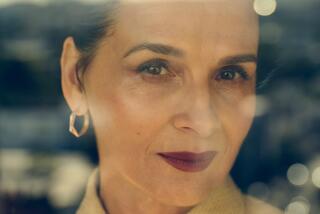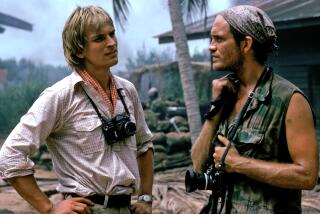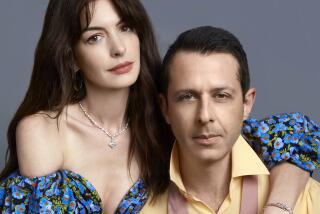A Friend in High Places
- Share via
Straight-arrow and subversive, made with simplicity as well as sophistication, “The Iron Giant” remembers the wonder of being a child and understands how to convey that in a media-savvy age. Both a step back and a step forward from the trends of modern animation, it feels like a classic even though it’s just out of the box.
While charming Disney animated features from “Beauty and the Beast” through the current “Tarzan” have provided hours of wonderful entertainment, there is nevertheless a sameness about their peppy musical formats and the wised-up patter of their characters. “The Iron Giant” does things differently.
Directed by Brad Bird, “The Iron Giant” is loosely based on something Ted Hughes, Britain’s poet laureate, wrote for his children after the death of their mother, Sylvia Plath. It’s a simple, straightforward tale of a small boy and his oversized, otherworldly friend, and Bird has wisely chosen both traditional and modern ways of visualizing it.
In a decision that fits well with the film’s 1957 setting, Bird has utilized old-fashioned, flat two-dimensional animation to tell most of his story. That makes sense for creating the Norman Rockwell-inspired town of Rockwell, Maine, and also makes for frames that look more like carefully drawn storybook illustrations than much of modern animation can manage.
When it comes to animating the 50-foot metal behemoth that gives the film its name, however, Bird and company went to computer-generated images to underline the creature’s differentness and to give this giant metal object a kind of grace and personality it might not otherwise have.
The key dramatically to “Iron Giant’s” success is a parallel ability to adroitly blend competing sensibilities. Written by Tim McCanlies from a screen story by Bird, the film has the same honest warmheartedness that marked the writer’s previous “Dancer, Texas Pop. 81.” But though it’s got heart, “Iron Giant” is far from square, exhibiting a dryly humorous Rocky and Bullwinkle-influenced anti-establishment sense of humor fueled by one of its main characters, an espresso-drinking hipster named Dean McCoppin (perfectly voiced by Harry Connick Jr.) who wears shades and listens to cool jazz far into the night.
Dean’s character is not the only time that “Iron Giant” makes good use of its 1957 setting. Various amusing segments remind us that this was an era characterized by science-fiction films about alien invaders as well as the intertwined fears of the Communist menace and the atomic bomb. Maybe people didn’t lock their doors, but there was considerable fear in the air.
Nine-year-old Hogarth Hughes (Eli Marienthal), by contrast, is completely unafraid, a feisty and independent tyke who lives with his hard-working waitress mother Annie Hughes (Jennifer Aniston) and is always game for adventure.
When Hogarth hears a local fisherman talk of sighting an enormous metal monster, he’s all ears. And when he hears suspicious noises outside his house one night, naturally Hogarth investigates. What he finds, to his complete shock, is a classic 1950s-type metal-eating robot, 50 feet tall, which the film’s opening shots have shown arriving from outer space.
Because Hogarth, in an “Androcles and the Lion” maneuver, helps the giant out of some difficulty, and because the iron man is something of a big kid itself, the two become friends. And though his voice (courtesy of Vin Diesel) sounds like a garbage disposal attempting to speak, the giant even learns to appealingly express himself in English.
Some of “Iron Giant’s” most appealing moments convey the pure glee Hogarth feels at having this completely delightful playmate. “My own giant robot,” he says, genially puffed up with pride. “I am the luckiest kid in America.”
But happy though he is, Hogarth is smart enough to know he has to hide the giant from the rest of Rockwell. “People just aren’t ready for you,” he says before choosing the junkyard run by hipster (and would-be sculptor) Dean as the most likely refuge.
A refuge proves especially necessary when officious government agent Kent Mansley (Christopher McDonald), a 1950s version of an X-Files investigator, starts snooping around town, trying to get on Hogarth’s good side by calling him “chief,” “scout,” “sport,” “skipper” and any other bogus appellation he can think of.
“The Iron Giant” takes special glee in poking fun at the pipe-smoking, trenchcoat-wearing Mansley, the epitome of wrongheaded, xenophobic authority whose thoughts about the giant boil down to, “we didn’t build it, that’s reason enough to blow it to kingdom come.”
While it does turn out that the giant is not always a benign figure, the lessons this film wants to teach are of the gentle variety. It is against guns, against killing, against nuclear weapons (which make a scary cameo appearance) and for the existence of souls and personal self-determination: Both Hogarth and the giant learn that “you are what you choose to be.”
In addition to calling the boy Hogarth after the British artist, the makers of “Iron Giant” pay specific tribute to other comic illustrators, from the makers of Superman to Will Eisner, creator of the cult-favorite Spirit. The film also echoes earlier efforts like “King Kong,” “Frankenstein” and “E.T.” but with a refreshing spirit of bemused, nonaggressive hipness that is completely, and delightfully, its own.
* MPAA rating: PG, for fantasy action and mild language. Times guidelines: The threat of nuclear disaster is a prominent plot point; the threats posed to the Iron Giant are scary and intense.
‘The Iron Giant’
Jennifer Aniston: Annie Hughes
Harry Connick Jr.: Dean McCoppin
Eli Marienthal: Hogarth Hughes
Vin Diesel: Iron Giant
James Gammon: Marv Loach, Floyd Turbeaux
Christopher McDonald: Kent Mansley
Released by Warner Bros. Director Brad Bird. Producers Allison Abbate, Des McAnuff. Executive producer Pete Townshend. Screenplay Tim McCanlies. Screen story Brad Bird, based on the book “The Iron Man,” by Ted Hughes. Editor Darren T. Holmes. Music Michael Kamen. Production design Mark Whiting. Art director Alan Bodner. Running time: 1 hour, 26 minutes.
In general release.
More to Read
Only good movies
Get the Indie Focus newsletter, Mark Olsen's weekly guide to the world of cinema.
You may occasionally receive promotional content from the Los Angeles Times.











